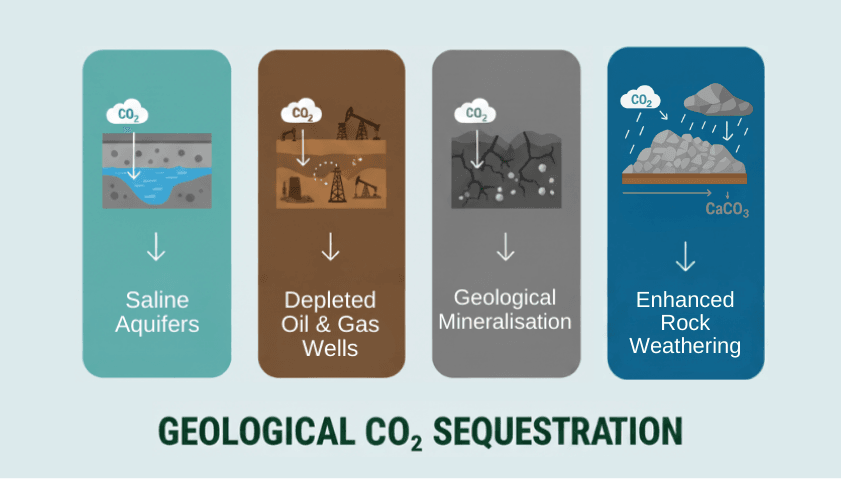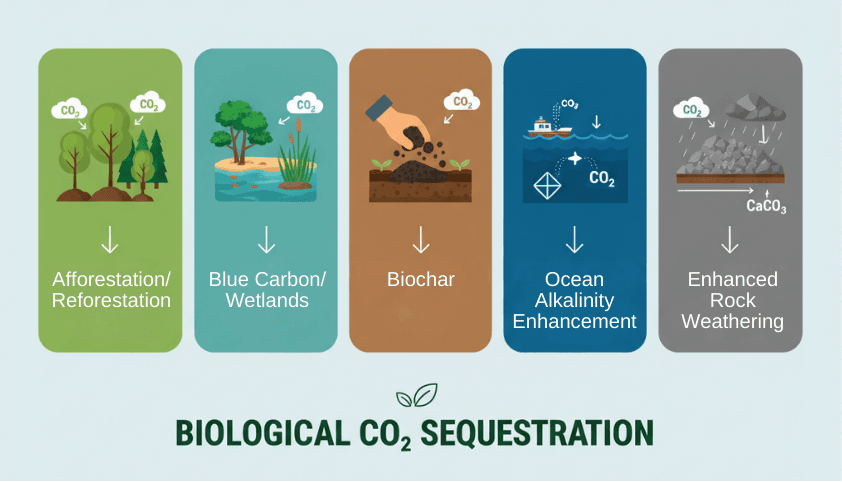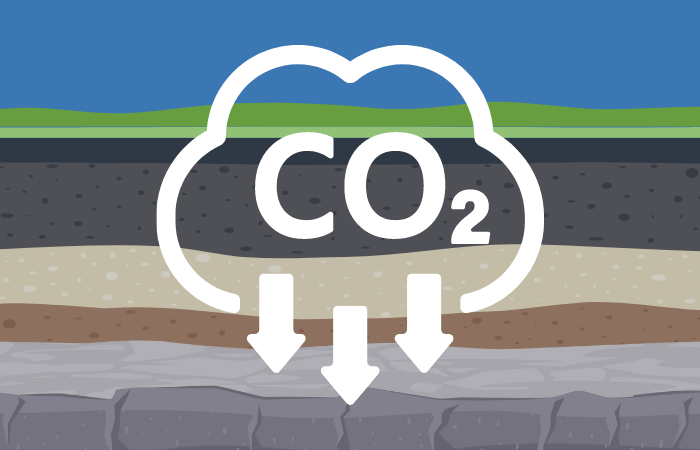What is Carbon Sequestration?
Carbon sequestration is a multifaceted strategy aimed at capturing and securely storing atmospheric carbon dioxide (CO2). Capturing the excess CO2 in the air caused by human activities will curb global warming and help mitigate climate change. (See: Why Direct Air Capture)
Types of CO2 Sequestration
Geologic and biologic are the two main approaches to carbon sequestration.
What is Geological Sequestration?
Simply put, geological sequestration is storing carbon dioxide in geological formations underground.
Once CO2 is captured, the next challenge is ensuring its long-term storage in a secure and environmentally friendly way.
This is where geological sequestration comes to the fore. The captured CO2 is mixed with water, becoming much like fizzy soda water, and then pumped deep underground (over 1000m down). Alternatively, it can be compressed to a liquid state and then injected deep into the Earth. The CO2 is securely trapped under a cap-rock, a layer of impermeable rock that seals in the carbon dioxide.
Various Geological Carbon Sequestration Methods
This article by NETL explains carbon storage in depth, but the main options for geological CO2 are:
- Saline aquifers
- Depleted oil and gas reservoirs
- Unmineable coal seams
- Organic-rich shales
- Enhanced Rock Weathering (both geological and biological)
Geological Mineralisation: Transforming CO2 into Rock
Basalt and peridotite are types of volcanic rocks abundant in magnesium and calcium minerals. When exposed to CO2, a natural mineralisation process occurs, where the CO2 reacts with these minerals to form stable carbonates. This process effectively turns the CO2 into solid rock, securely storing it for millenia and preventing the release of CO2 back into the atmosphere.
The chemical reactions involved in this mineralisation process are not only efficient but also environmentally benign, offering a sustainable and natural solution to the carbon storage challenge.
Enhanced Rock Weathering (ERW) is primarily a geological (or geochemical) CO2 sequestration method, but it is often described as involving both geological and biological processes. ERW accelerates the natural geological process of rock weathering where atmospheric CO2 dissolves in rainwater to form carbonic acid which in turn reacts with silicate materials to convert the CO2 into stable bicarbonates.
Summary
Geological Storage
Underground injection into reservoirs or formations
• Cost: $10-20 per tonne for storage
• Long-term storage potential
• Monitoring required
Geological Mineralisation
Converting CO₂ to stable carbonate minerals
• Cost: $50-100 per tonne
• Permanent storage
• No monitoring needed after conversion

Is There Enough Space to Store Carbon Geologically?
The direct answer – yes. The International Energy Agency reported that there is an estimated 8,000 to 55,000 billion tonnes of CO2 storage capacity in saline rock formations and depleted oil and gas wells. This accounts for both the onshore and offshore capacity. However, in reality, not all this capacity is entirely suitable for CO2 storage, with both technical and commercial feasibility issues to consider.
What is Biological Sequestration?
On the other hand, biological carbon sequestration is the capturing and storing of atmospheric CO2 in the natural environment through biological processes. While this happens naturally, especially in ‘carbon sinks’ like forests, peatlands and oceans, it can be enhanced by human activities.
Examples include afforestation/reforestation, ocean fertilisation or alkalinity enhancement, restoring wetlands, biochar, and enhanced weathering of rocks (e.g. basalt) by crushing and spreading them. (See: Carbon Dioxide Removal Technologies)
The down-side of biological sequestration is the vulnerability of nature – fires can destroy forests, land-use can change and intense climate events can cause great damage – which will result in the captured CO2 being released again into the air.

CO2 Capture and Sequestration is Paving the Way for a Sustainable Future
As we look for ways to fight climate change, technologies for capturing and storing carbon emerge as promising solutions. By harnessing the power of nature combined with developing technology, we can not only reduce current CO2 emissions but actively reverse the climate change, paving the way for a more sustainable and resilient future.
For more:
- What is CO2 Utilization?
- Direct Air Capture Cost Compared to Cost of Inaction on Climate Change
- Hard to Abate Industries and the Decarbonization Challenge
- Is DAC Viable?
- Advantages of Direct Air Capture

